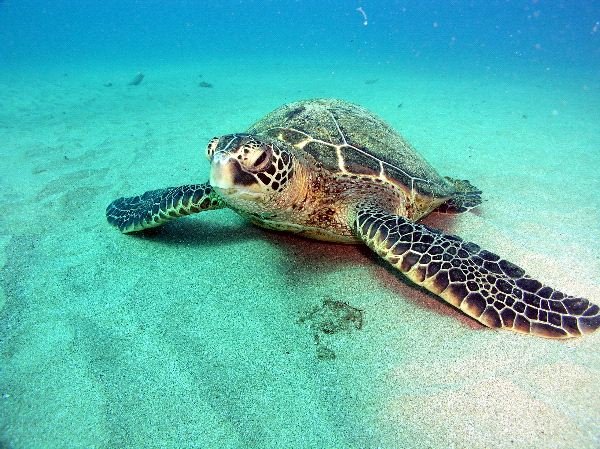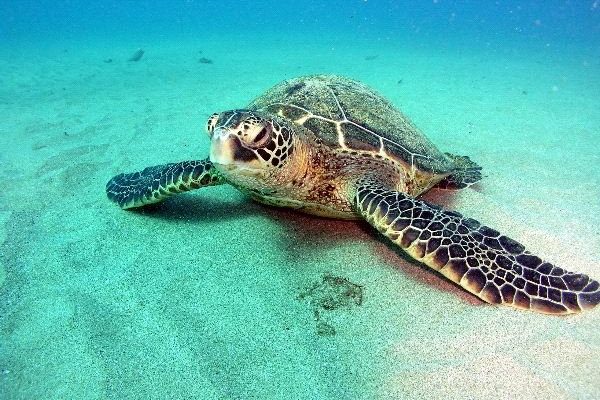
The green sea turtle, or *Chelonia mydas*, is known for its beautiful olive-green shell and herbivorous diet. You might be surprised to learn that these turtles can weigh up to 400 pounds and have been around for over 100 million years! They have flourished in oceans across the globe, from the warm Caribbean seas to the coastlines of Australia. It’s their unique adaptations that help them thrive in these various environments. So, grab your snorkel, and let’s explore these incredible features!
Streamlined Body Shape for Efficient Swimming
One of the first things you notice about green sea turtles is their unique body shape. Their streamlined, oval-shaped bodies are specifically designed for moving gracefully through the water. This shape minimizes drag as they swim, allowing them to glide effortlessly. It’s like watching a plane take off—everything is built to slice through the air, and for turtles, it’s all about cutting through the water smoothly.
In addition to their body shape, green sea turtles have an incredible set of flippers. Their front flippers are long and powerful, acting like wings that propel them forward. This enables them to swim at speeds of up to 35 miles per hour during short bursts. Whether they’re searching for food or evading predators, these flippers are essential for navigation and speed in the open sea.
Turtles also have a unique adaptation called buoyancy control. They can adjust the air in their bodies, helping them float or dive deeper into the ocean. This ability allows for energy-efficient movement, especially when they’re searching for sea grasses and algae to munch on. Honestly, it’s impressive how evolution has equipped these creatures for life underwater.
Strong Flippers for Diving and Maneuverability
As we mentioned, the green sea turtle’s flippers are crucial for swimming, but they serve more purposes than just propulsion. These strong flippers allow the turtles to dive down to impressive depths, sometimes reaching 1,000 feet or more in search of food. Here’s the thing: diving this deep requires not only strength but also incredible stamina.
When the green sea turtle dives, it uses its flippers to maneuver in tight spaces, like coral reefs. Their dexterity helps them navigate through these complex environments, which are often bustling with life and a bit chaotic. Imagine a crowded subway during rush hour—everything moving quickly and needing to find a balance. The turtles manage to glide through with surprising elegance.
Moreover, the flippers are also necessary for basking on sunny beaches. While they’re not the fastest on land, they can push themselves onto sandy shores to soak up the sun, regulate their body temperature, and even lay eggs. It’s one more reason why their flippers are such a vital part of their adaptation toolkit.
Specialized Diet and Digestive System
Green sea turtles are known for their herbivorous diet, primarily munching on sea grasses and algae. This diet is a key adaptation that differentiates them from many other turtle species. It’s like having a one-of-a-kind recipe that works perfectly for their lifestyle. Eating these plants provides essential nutrients and helps maintain healthy ecosystems in ocean habitats.
Here’s where their digestive system plays a crucial role. Green sea turtles have specialized bacteria in their guts that help break down the tough fibers in sea grasses and algae. This process allows them to absorb maximum nutrients. You might be thinking, “How does that even work?” Well, think of their digestive system like a compost bin—each part works together to transform raw materials into nourishing food.
This dietary choice also gives them a competitive edge. While many marine creatures have to hunt for food, green sea turtles can forage on the ocean floor, where they can find plenty of their favorite snacks. This not only helps them thrive but also keeps the underwater environment balanced.
Coloration and Camouflage for Protection
The green sea turtle’s shell is not just pretty to look at; it also serves an important purpose. Their dark, olive-green coloration helps them blend in with the sea and the ocean floor. This natural camouflage is a critical adaptation for survival. When they’re resting or feeding, the turtles can easily hide from potential predators like sharks.
Additionally, their shell is shaped to deflect harsh currents and protect against injuries from rocks or coral. It’s kind of like wearing a suit of armor—providing safety while also making it harder for predators to spot them. Honestly, this blend of beauty and functionality is just fascinating!
Another adaptation related to their coloration is the ability to change it slightly based on their surroundings. This helps them stay hidden and safe in various underwater environments. It’s similar to how a chameleon adapts its colors to fit in with its environment—only with the turtles, it’s less about changing color and more about choosing the best areas to blend in.
Communication and Social Behavior
Believe it or not, green sea turtles also have some fascinating social behaviors and communication methods. They are known to use a range of sounds to communicate with each other. From hisses to squeaks, these vocalizations help them interact, especially during mating season. You might be wondering, “How do they manage all of this underwater?” Well, it turns out that sounds travel well in water, making it an effective means of communication.
Additionally, green sea turtles often gather in groups, especially when foraging for food or during nesting season. This social behavior provides safety in numbers, reducing the risk of any one turtle becoming a target. Picture a group of friends at a concert—together, they can enjoy the atmosphere while also keeping an eye out for any threats.
Interestingly, female green sea turtles are known to return to the same nesting sites year after year. This behavior suggests they may have a homing instinct linked to their environmental memory. Think of it as a phone app that helps you navigate back to your favorite spots—except these turtles use their internal compass to find their way home.
Adaptations for Breathing and Diving
Breathing is another key aspect of a green sea turtle’s life, especially since they spend so much time submerged. They have fascinating adaptations that allow them to hold their breath for extended periods. A green sea turtle can stay underwater for about 4 to 5 hours if they remain calm and still. To achieve this, they slow down their heart rate and redirect blood flow to vital organs.
You may be thinking, “That sounds like a talent!” Well, it truly is. It’s the equivalent of holding your breath while swimming, but these turtles take it to a whole new level. When they do need to surface, they take big gulps of air, filling their lungs to prepare for the next dive.
Their nostrils are positioned on top of their heads, making it easier for them to breathe even when they are just below the water’s surface. This unique design is like having a snorkel built right into their bodies! So, when the time comes to take in some oxygen, they simply pop their heads up, take a breath, and dive back down to continue their underwater adventures.
The green sea turtle is a true marvel of nature, perfectly adapted to survive and thrive in the ocean. From their streamlined bodies to their rich diet and incredible communication skills, every feature plays a vital role in their underwater lifestyle. It’s like they’re living proof of how evolution creatively solves challenges.
As we continue to protect our oceans and their inhabitants, let’s remember the incredible adaptations of the green sea turtle. Each turtle embodies resilience and beauty, reminding us of the importance of safeguarding these ancient creatures for future generations. So, the next time you find yourself near the ocean, take a moment to appreciate the wonders beneath the waves. You might just be lucky enough to spot one of these magnificent sea turtles gliding gracefully by.

